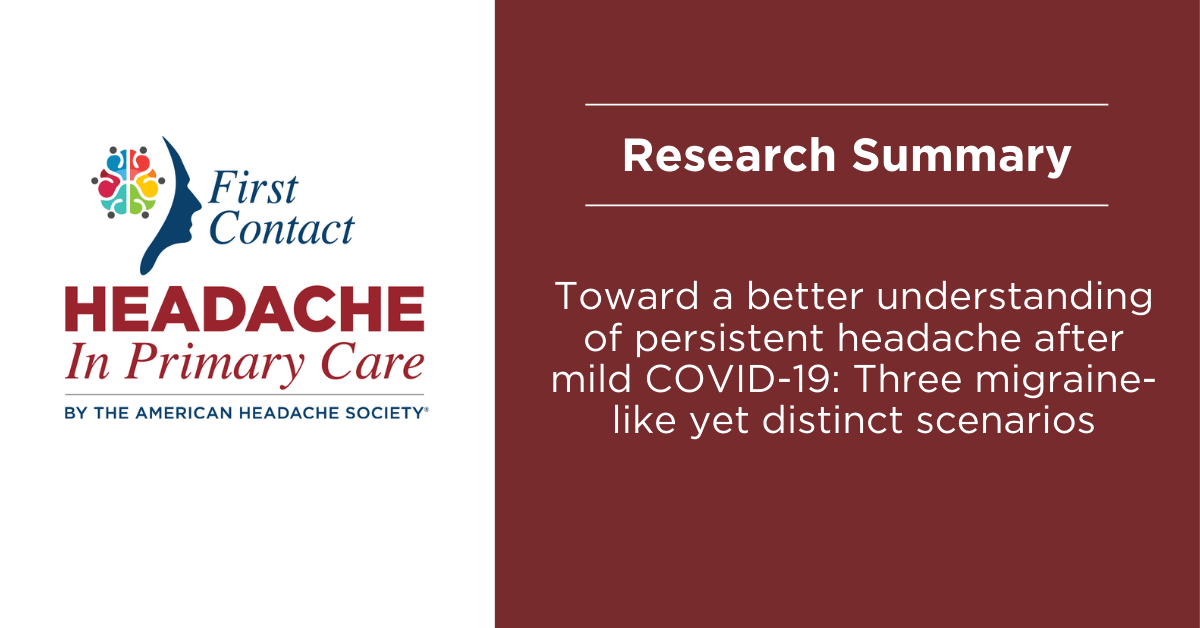
Research Summary: Toward a better understanding of persistent headache after mild COVID-19: Three migraine-like yet distinct scenarios
Headache®: The Journal of Head and Face Pain published “Toward a better understanding of persistent headache after mild COVID-19: Three migraine-like yet distinct scenarios.”
Some patients do not fully recover after the acute phase of COVID-19 and experience “post-COVID syndrome.” Persistent headache after the acute phase of COVID-19 is often referred to as “post-COVID headache.” Different headache types can result as sequelae of COVID-19 infection and may be a result of different pathophysiological mechanisms with different prognoses and responses to headache treatments.
Study Results
- Three patients evaluated in a headache clinic with “post-COVID headache” were included in this brief communication.
- The focus of the article is on patients with a history of mild COVID-19 infection (confirmed by RT-PCR test) and migraine-like headache symptoms after the acute phase of COVID-19 infection (migraine phenotype).
- Patients had normal brain imaging and lab work that did not show any other secondary cause of headache.
Case 1. “Migraine Chronification”
- This patient had a history of episodic migraine prior to COVID-19 infection, and headache was the first symptom after COVID-19 infection.
- The patient subsequently presented with persistent headache about 6 months after the initial COVID-19 diagnosis.
- Headache improved after treatment with amitriptyline and onabotulinumtoxinA.
Case 2. “Long-Lasting COVID Headache”
- This patient, without a previous headache disorder, had a mild case of COVID-19 infection.
- Headache started a few days after other COVID- 19 symptoms appeared.
- The patient first visited the headache clinic due to persistent headache about 5 months after COVID-19 infection.
- Amitriptyline combined with onabotulinumtoxinA treatment helped with headache prevention, and almotriptan was helpful for acute headache management.
Case 3. “Delayed-Onset-COVID Headache”
- This patient had no headache in the acute phase of COVID-19 infection.
- When the patient’s respiratory symptoms began to improve, the first presence of headache was reported. The patient’s first visit to the headache clinic with persistent headache was about 5 months after the initial COVID-19 diagnosis.
- Daily disabling headache did not improve after treatment with amitriptyline, candesartan, onabotulinumtoxinA, escitalopram and rizatriptan, nor after counseling on lifestyle changes.
Implications for Primary Care Physicians
- These three clinical cases demonstrate the existence of phenotypically similar migraine-like headache after mild COVID-19 infection, which could result from different pathophysiological mechanisms, such as activation of trigeminovascular system by the virus, altered levels of glutamate and hypoxic injury.
- Future research studies should focus on identifying what factors (e.g., migraine history, migraine-like features, headache in the acute phase, headache onset post-COVID, presence of associated symptoms) determine a response to the selected treatment and prognosis in patients with “post-COVID headache.”
This summary is part of the First Contact – Headache in Primary Care initiative, an American Headache Society program that provides educational resources to empower healthcare professionals and improve headache and migraine care. We encourage providers in all stages of their careers to visit our homepage to access educational tools to improve patient care.


